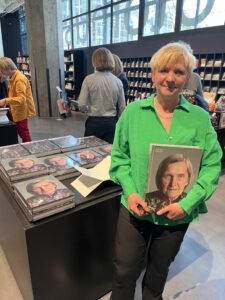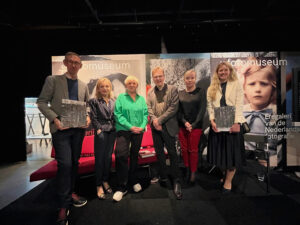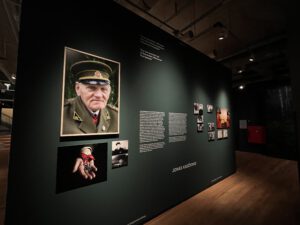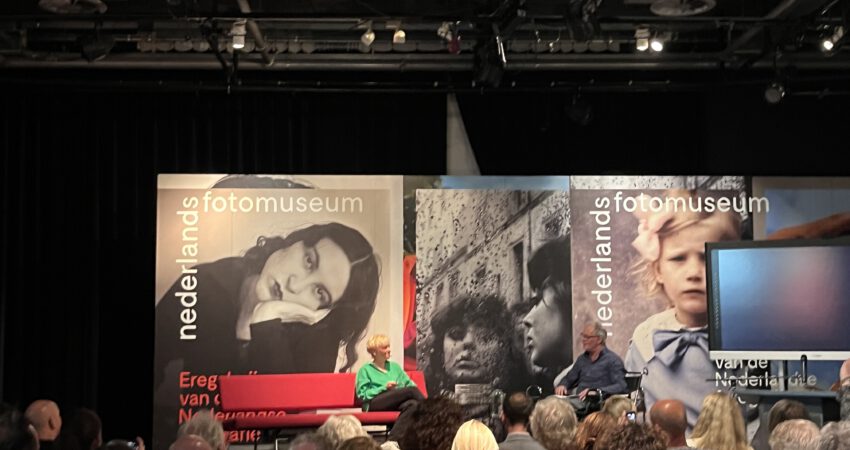By Beata Bruggeman-Sekowska
On May 13th at the Nederlands Fotomuseum a launch of the ‘’Siberian Exiles’’ part 2 by a talented documentary photographer Claudia Heinermann took place, a very special project devoted to the oppression of communism, abuse of power and crimes against humanity. In part 2 of the trilogy Claudia Heinermann follows the story of Lithuanian, Latvian and Estonian men and women who joined the resistance to fight for the freedom of their country.
Claudia Heinermann’s work
Since 2016 she has been working on a trilogy ‘Siberian Exiles’ about the deportations from the Baltic states to Siberia under the Soviet regime. In the three parts she gives the eyewitnesses a chance to share with us their traumatic stories about the deportations from the Baltic states to Siberia under the Soviet regime, about the occupation of their homeland, the resistance movement, imprisonment in Gulag camps and what happened to them after their release.

Claudia Heinermann ©communications-unlimited.nl
Claudia Heinermann travelled to the places where the communist crimes took place and she kept coming across new traumatic stories. As a documentary photographer she points out that it is her aim to contribute to keeping all these memories, which give us a glimpse into a hidden history, and which protects them from being forgotten.
Claudia Heinerman works are intense, with focus on portraits and eyes of the people she is presenting. She works with natural light only, no flashlights or studio lights.
Since the feeling of trust is the absent feeling among those who suffered from communist oppression it was very demanding for Claudia Heinermann to reach those who she was portraying, to let her in their lives, their traumatic memories.
Launch of the 2nd part of ‘’Siberian Exiles’’
The launch of the 2nd part of ‘’Baltic exiles’’ event was attended by 150 guests including Deputy Head of Mission of the Lithuanian Embassy- Ms. Giedrė Geleževičienė , Latvian Ambassador Ms Aiga Liepina and Estonian Ambassador- Mr Lauri Kuusing and members of the board of the European Institute on Communist Oppression Aloys Bruggeman and Beata Bruggeman-Sekowska.

From left Estonian Ambassador- Mr Lauri Kuusing, EIOCO president Beata Bruggeman-Sekowska, Claudia Heinermann, Aloys Bruggeman EIOCO board member, Latvian Ambassador Ms Aiga Liepina, Deputy Head of Mission of the Lithuanian Embassy- Ms. Giedrė Geleževičienė ©communications-unlimited.nl
Frits Gierstberg – curator Nederlands Fotomuseum interviewed Claudia Heinermann and in his introduction pointed out that her works make it possible to feel some of the pain the victims of communism have experienced.
All three ambassadors repeated in their speeches that history is repeating itself now in Ukraine and Russians who had committed these terrible crimes had never been punished and therefore impunity grained in Russian DNA.
Ambassadors pointed out that 4 may 1945 was not the end of war but it meant new occupation, repressions for their countries since they were oppressed by the Soviet Russia till 1990.
They expressed their gratitude to Claudia Heinermann that she through her unique project shared with the western world this terrible history of their nations western countries knew so little about.
Deputy Head of Mission of the Lithuanian Embassy- Ms. Giedrė Geleževičienė shared her personal story telling that her grandmother when she was 15 was left alone behind as the rest of her family fled and she became a teacher of the Lithuanian language as a sign of her own resistance.
Latvian Ambassador Ms Aiga Liepina continued that the Soviet regime tried to break the backbone of the nation by executing exiles but the communist oppressors did not manage to achieve it.
Estonian Ambassador- Mr Lauri Kuusing added that every 5th Estonian person was deported, imprisoned or killed, that every family was a victim and that behind these numbers are names and behind these names are stories. Stories which are now heard thanks to Claudia Heinermann.
Mr Ambassador also shared a personal story by telling that he took his father who is now 90 years old to the exhibition based on the 1st part of the project ‘’Siberian Exiles’’ and that his father was so touched that he started telling the family stories for the first time.
Background info about ‘’Siberian Exiles’’
The monumental works ‘’Siberian Exiles’’ consists of three parts. The first part of ‘’Siberian Exiles’’ is about the deportations of 6 Lithuanians: Irena, Nijolė, Jonas M, Vilius, Jonas P and Vaidutis to the Laptev Sea in the arctic. The Lithuanian deportees had the task of setting up a fishing industry above the polar circle. They were left there without housing, protective clothing, food or technical equipment. During snowstorms, they had to build their own huts with their bare hands. Small children often had the task of keeping the fire burning and collecting driftwood, while the older children were put to work in children’s brigades. The exiles suffered from constant hunger and many illnesses such as scurvy. For many it became a death sentence. Read more here: https://siberianexiles.com/siberian-exiles-1/
In part 3 of the trilogy, Claudia Heinermann follows the story of Marju, an Estonian deportee. This led her to a nuclear test site in Kazakhstan and the beginning of the Cold War. Read more here: https://siberianexiles.com/siberian-exiles-3/
The project was made possible with support by crowdfunding and various fonds.

Exposition at the Nederlands Fotomuseum ©communications-unlimited.nl
Historic background
On 23 August, 1939 the Molotov-Ribbentrop Pact was signed, between Nazi Germany and Communist Russia. It comprised secret clauses in which they divided Eastern and Central Europe. Poland was divided into a German part and a Soviet part, Lithuania was left to Germany and Latvia, Estonia and Finland were left to the Soviet Union. After the adjustment of the pact on 28 September Lithuania finally was left under Soviet control. On June 22, 1941 Germany declared war against Russia and the pact was broken. In 1944 Communists annexed the Baltic states as Soviet Republics and occupied them till 1991. Stalin in order to break the resistance of the Baltic States against communism deported from Lithuania, Latvia and Estonia ( countries counted no more than 7 million inhabitants), between 1941 and 1953 600,000 people to Siberia, remote parts of the USSR, the area of Arctic Circle and Central Asia. Men were sent to hard labour camps (Gulags) and women and children were sent to remote areas to do forced labour. Many of them did not survive.
Photos and source: ©communications-unlimited.nl
Read our previous interview with Claudia for more background information here:
Read also:



Follow Us!